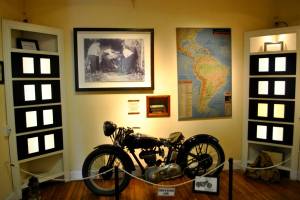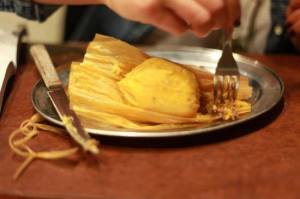To complement my post on food in Northwestern Argentina, I decided to write this post about drinks in Argentina. I’m not specifying Northwestern Argentina because I think a lot of these things go for the entire country (with the exception of maybe one or two). This post really has no particular order to it, but I would say that the top three are the top three here.
10. Licuados

Clémence’s last licuado in Argentina before going back to France 😦
A licuado is a smoothie or a shake. At any restaurant or café, or at specific places for licuados, you can get any combination of fruits blended with either water or milk, and with or without sugar added. My personal favorite is strawberry-banana with milk! These usually run about 20 pesos ($3 ish) for a huge one at a cheap little licuado place, or 20 pesos for a small-ish one at a restaurant or café.
_________________________________________________________________________________
9. Fresh Juices
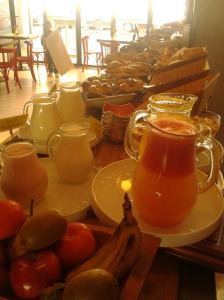
Fresh juices at Aniceto
Fresh-squeezed orange juice and grapefruit juice is all the rage here. Not much more I can say, other than YUM! Sidenote: That picture is from Aniceto, my all-time favorite breakfast place! Juices are on the right in big pitchers, and there’s yogurt and milk on the left. It’s a huge breakfast buffet that goes all the way down the bar. Mom, we’re going there when you are here. I promise 🙂
_________________________________________________________________________________
8. Flavored Water

Also at Aniceto. They offer you a glass of this grapefruit-infused water the minute you enter the restaurant!
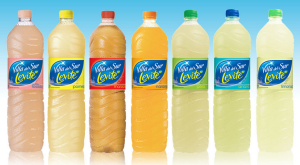
Pink grapefruit, grapefruit, apple, orange, pear, pineapple, lemonade
I feel like flavored water was a more recent trend in the US. Maybe it was here, too. I don’t know. But there is a huge variety of flavored water products out there, both regular and carbonated in a bunch of flavors. Of course, anytime you get a small bottle of this they will give you a straw, because no one drinks out of bottles here without a straw. I still can’t figure out how to get the last of the water at the bottom with the straw. I usually give up and go all American on it and just drink it “normally.”

The print is small, but it totally says “Berries”
Out of all the flavored waters, my personal favorite would have to be “berries” (above). The word on the packaging is literally “berries,” pronounced “berries” with a very strong Latin accent. And the “rr” is a little rolled. Why it’s not just called “frutos del bosque” or “frutos rojos” I will never know.
_________________________________________________________________________________
7. Coca Tea

This one has a LOT of coca leaves in it, but you get the idea.
This is very particular to NW Argentina and other Andean countries (Bolivia, Perú, Ecuador). In a cup of hot (boiling) tea, you just put in some coca leaves and let it steep for a little bit. Yes, coca leaves that are eventually used to make cocaine. Family and Rotarians, before you freak out that I’ve been consuming cocaine, think of it this way, though: considering an entire bottle of wine as one grape is the same thing as thinking of cocaine like one coca leaf. It’s not cocaine. Anyways, enough of that rant. It’s basically a mild stimulant (keeps you awake) and also suppresses appetite and gets rid of altitude sickness (hence popularity in Andean countries).
_________________________________________________________________________________
6. Submarinos

Stir until combined!
The submarino is the Argentine after-school snack for kids, during merienda (snack) time from about 5-7 PM or so. It’s can also be for breakfast but I don’t think it’s as common then. You get a large glass of hot milk, and a chocolate bar. Drop in the chocolate and wait for it to melt. Stir it up, drink, and enjoy! It’s called a submarino because the bar of chocolate is like a submarine going underwater! Cute, right?
_________________________________________________________________________________
5. Malbec

If you know wine, you know Malbec. Most people know Mendoza for their wines, but I am a strong supporter of Cafayate! Etchart and El Esteco are two of the big bodegas there, but I’m fairly sure that any bodega in Cafayate produces Malbec. Though originally from France, the Malbec grape is now associated with Argentina because it’s done well in the warm and dry climate here. I’m quoting from the Nanni bodega description here, but “On the nose, it’s intense and fruity with aromas of red berries and fruits of the forest. There are notes of plums, cherries, cassis, and berries. It is a lively red wine with very good structure, a perfect match for red meats and pasta.” For more information about Malbec, check out this fact sheet from Colomé.
_________________________________________________________________________________
4. Salta Rubia/Negra


Quilmes is the big national beer. Salta Rubia and Salta Negra are the two big beers in Salta (obviously). A liter bottle will run you about 10 pesos from a convenience store ($1-something), or about 30 pesos at a restaurant ($3-something). Salta Negra is a dark beer but is really quite light – it isn’t heavy at all. And Salta Rubia is basically like Miller Lite.
_________________________________________________________________________________
3. Fernet

If you see a group of Argentinians at a festival or fair with a Coke bottle, there is a 99% chance that there’s also fernet in that Coke bottle. It is (thanks Wikipedia) “A type of amaro, a bitter, aromatic spirit. Fernet is made from a number of herbs and spices which vary according to the brand, but usually include myrrh, rhubarb, chamomile, cardamom, aloe, and especially saffron with a base of grape distilled spirits, and colored with caramel coloring.” That description sounds horrendous. Oh, and even better, farther down the article it says “Its smell has been described as “like black licorice-flavored Listerine.” Thirsty yet?
It’s super super popular here at bars and convenience stores — you will see promos for a bottle of fernet, coke, and ice for 70-80 pesos ($9-10). Apparently they make 25 million liters of Fernet a year in Argentina. It’s not my favorite thing ever created.
_________________________________________________________________________________
2. Torrontés
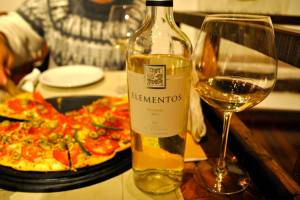
Torrontés is the lesser-known Argentine wine, but in my opinion I think it’s worthy of much more fame! This fact sheet from Bodega Colomé explains a lot (if you are really into that kind of stuff). Torrontés is from Salta province — the grapes for Torrontés thrive at high altitudes where there is a big daily range in temperatures. In Salta, most of the vineyards are at about 1700 meters and it gets hot (75-80) during the day and chilly at night (40-45 or even cooler). It’s a very light white wine that is fruity and very fresh tasting. There is also Cosecha Tardía at many bodegas, which means “Late harvest” – the grapes are left on the vine longer, so the wine is sweeter. Nanni is a bodega that is certified organic and they have a good Cosecha Tardía Torrontés. Grandma, I will try to bring you a bottle because I know you like white wine! 🙂
_________________________________________________________________________________
1. Mate

This is what grad school looks like here: reading and mate.
Mate is the great Argentinian drink. Pronounced mah-tay (not mate, like g’day mate), it’s literally is defined by law as the national infusion. The Wikipedia article is actually super informative and well-done, but here’s my explanation.
Glossary:
Mate: The physical gourd/holder – mine at left is striped and made of wood. These can be made of a gourd, a number of different types of woods, ceramic, etc.
Bombilla: The special straw used for drinking mate. It has tiny holes at the bottom so that the water can get through, but not the…
Yerba: Literally yerba mate, a plant. In Salta most people add other herbs like rica rica, burro, cedrón, and other stuff. My apologies for not knowing these words in English, I’ve only ever had to describe this stuff in Spanish. Anyways, the flavor of brewed yerba mate resembles an infusion of herbs and is reminiscent of some varieties of green tea. Mate has caffeine in it. There is an entire aisle of all major grocery stores in Argentina that is devoted to different kinds of yerba mate. There are many different brands and also different infusions – you can get orange mate, lemon mate, grapefruit mate, coffee mate (which I have yet to try), and just regular old mate. They ALL taste different, though, and it’s a huge process trying to figure out which one you like best.
Termo: A vital sidekick to mate is a thermos, usually a large one that holds 500mL-1L of water. This is because each little mate doesn’t actually have much to it, so you end up drinking a ton.
Process:
Pour yerba mate into the mate, filling it about halfway or maybe 2/3. Covering the top of the mate, shake it hard and then dump it into your palm and then back into upright position. Your palm will have a bunch of dust from the yerba mate on it. Brush it off. Repeat this process 2-3 times.
Then I add different herbs into mine, usually mostly just cedrón (which is lemon verbena, I do know this one in English! Go me!)
Then add some sugar (option) into the bottom and gently shake the mate so that the yerba is kind of on an angle. Put in the bombilla and then add a little bit of hot (not boiling water). I usually let it steep for about a minute, just to get the yerba at the bottom wet, and then add a little more water. Then drink until the straw makes the “Knock that off stop slurping with your straw!” noise. Totally not rude in mate-drinking land! 🙂
Add more water. Repeat. After about 10-15 times, the mate starts to lose its flavor so you usually dump it out and re-do the process.
 Social Norms: Drinking mate is done in many different settings. At work (no matter where you work). In the car. At the library. In the plaza. At the park. In class (high school or college). In private tutoring classes/lessons. When someone invites you to their house. On long-distance busses. The list goes on.
Social Norms: Drinking mate is done in many different settings. At work (no matter where you work). In the car. At the library. In the plaza. At the park. In class (high school or college). In private tutoring classes/lessons. When someone invites you to their house. On long-distance busses. The list goes on.
When drinking mate with friends… see left, long story behind that picture but that’s me, Clémence, and a friend of hers/federal police officer who invited us to drink mate while we were waiting for her delayed flight at the Salta airport… Sorry. I digress.
When drinking mate with friends, the person preparing the mate (Person A) is always the first one to drink it because the first mate is a little bitter/everything isn’t mixed together right. Person A holds the thermos so they have all the power. They fill it back up and pass it to Person B, straw facing that person. When Person B is done, they pass it back to Person A, again, straw facing them. They refill it for Person C, and give it to Person C. So on and so forth.
Mom, I know you are having a panic attack about germs at this point. This could be why I keep getting sick, now that I think of it. Some people will wipe off the straw with a paper towel but most of the time you all just drink out of the same straw.
The important thing about mate is that you aren’t supposed to say “gracias” until you are done (done as in you don’t want anymore).
All of these insane minute cultural things took me FOREVER to figure out/learn/have explained to me.
Other Fun Facts:
Tereré: It can also be made with cold water or fruit juice, and this is popular in NE Argentina where it’s all rainforesty (by Iguazú), in Paraguay, and Southern Brazil.
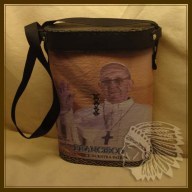 There’s also a thing designed to hold your mate set for mates on-the-go. Apparently there’s one with the Pope on it (he’s Argentinian in case you didn’t know that). I just found this on GoogleImages and I literally can’t stop laughing.
There’s also a thing designed to hold your mate set for mates on-the-go. Apparently there’s one with the Pope on it (he’s Argentinian in case you didn’t know that). I just found this on GoogleImages and I literally can’t stop laughing.
And there’s mate on the go. It’s a plastic cup and comes with a plastic straw.
And that’s Argentinian drinks in a nutshell! 🙂





